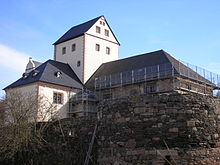Mildenfurth Monastery
The monastery Mildenfurth ( BMV and . St. Vitus ) is a former Premonstratensian - Canons in the district Mildenfurth in Wünschendorf / Elster in the district of Greiz in Thuringia .
history
The monastery was founded as a Premonstratensian provost in 1193 by Vogt Heinrich II von Weida . The first canons came from the Liebfrauenstift in Magdeburg and later looked after eight parishes and one hospital. The Romanesque collegiate church was built around 1200, some parts of which are still preserved today. It was a three-aisled basilica in a bound system with a staggered choir. The cloister followed to the south. Its south wing with the adjoining refectory has been partially preserved. Part of the area is still surrounded by a very high and defensive wall with loopholes and Romanesque entrance gate.
The Mildenfurther Klostermühle was first mentioned in a document in 1260. A 1500 meter long mill ditch from the crow's wood supplied the mill with water. The former water mill is located outside the former monastery grounds. In 1995 the machines in the mill for the agricultural cooperative Köckritz were still turning for compound feed production. After modernization, compound feed production was stopped on October 30, 1999.
In 1313 the attempt to join the Cistercian order failed . Mildenfurth remained premonstratensic and even joined the reform of the order in 1457 with 33 canons. Between 1436 and 1440 Sigismund von Sachsen stayed in the monastery, making him feel closer to a nun he had fallen in love with.
In 1526 the Reformation was introduced in the country , which led to the abolition of the monastery by 1543. In the end ten Premonstratensians lived in the monastery under Provost Konrad Berger. In 1544 the area was sold to Matthes von Wallenrod, fortress captain of Coburg , who had it converted into a Renaissance castle in 1556 . The transept, the main choir and parts of the nave were integrated into the palace. The west tower was removed, only the ground floor with the former main portal remained. From 1617, after being acquired by Elector Johann Georg I, the palace was a hunting lodge and later became a Saxon chamber property , and the Mildenfurth office was established. From 1816 to 1918 Mildenfurth, including the estate and castle, belonged to the Grand Duchy of Saxony-Weimar-Eisenach , and in 1918 it was taken over by the State of Thuringia. Various uses followed from 1945 to 1988, such as a retirement home and fruit store.
The monastery has been used by the artist couple Volkmar Kühn and Marita Kühn-Leihbecher since 1992 as an exhibition space and since 2007 as a gallery. The complex has belonged to the Thuringian Palaces and Gardens Foundation since 1995 and is being restored.
The working group for art and culture "Kloster Mildenfurth" organizes concerts, theater performances and book readings in the old monastery walls. The small barrel vault regularly invites you to exhibitions of modern visual artists. Sculptures by Volkmar Kühn have found their permanent place in the monastery garden.
literature
- Herbert Eichhorn: Premonstratensian Monastery Mildenfurth near Wünschendorf, Small Art Guide No. 2370, Regensburg 2001.
- Herbert Eichhorn: The former Premonstratensian monastery and palace complex Mildenfurth. Origin, use and consequences for monument preservation, workbook of the Thuringian State Office for Monument Preservation, new series 7, Erfurt 2002.
- Dehio, Georg, edited by Stephanie Eißling, Franz Jäger and other specialist colleagues: Handbuch der deutschen Kunstdenkmäler, Thuringia. Deutscher Kunstverlag, 2003, ISBN 3-422-03095-6 ,
Web links
- Information on the monastery complex at www.thueringerschloesser.de
- Information about the monastery at www.wuenschendorf.de
- Information on Volkmar Kühn
Individual evidence
- ^ Günter Steiniger: Mühlen im Weidatal , Rockstuhl: Bad Langensalza 2010, pp. 221, 225 ISBN 978-3-934748-59-0
- ^ Historical-topographical pocket book of Jena and its surroundings by JC Zenker, Jena 1836
Coordinates: 50 ° 47 '24.9 " N , 12 ° 4' 52.4" E



